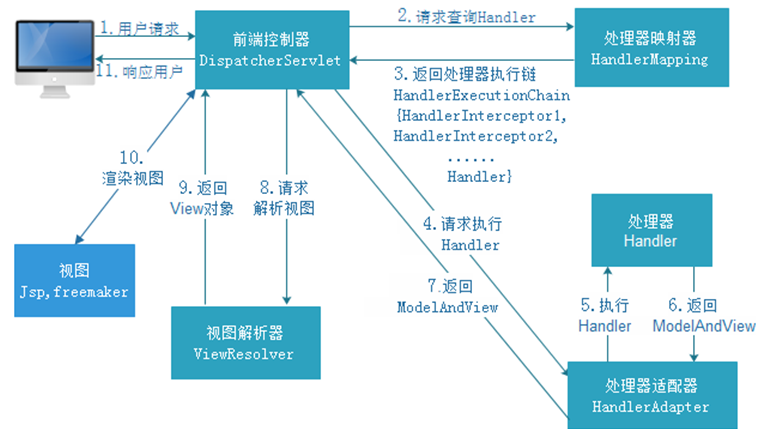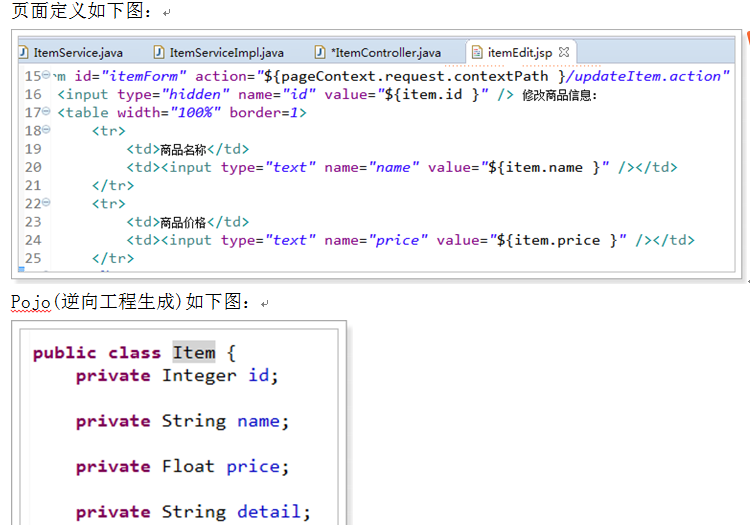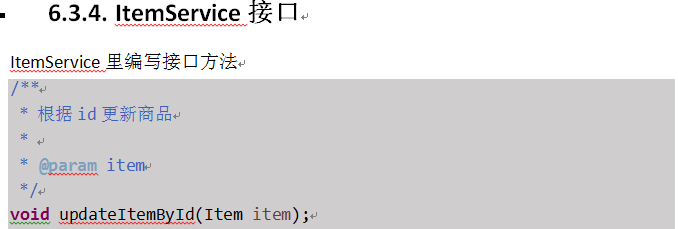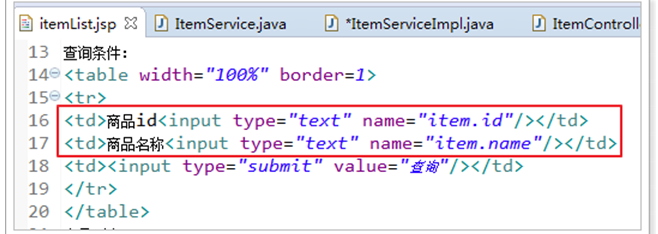springmvc是什么
Springmvc处理流程


入门程序
1.创建工程
2.导包
3 配置文件

<?xml version="1.0" encoding="UTF-8"?> <web-app version="3.0" xmlns="http://java.sun.com/xml/ns/javaee" xmlns:xsi="http://www.w3.org/2001/XMLSchema-instance" xsi:schemaLocation="http://java.sun.com/xml/ns/javaee http://java.sun.com/xml/ns/javaee/web-app_3_0.xsd"> <display-name></display-name> <welcome-file-list> <welcome-file>index.jsp</welcome-file> </welcome-file-list> <!-- 前端控制器 --> <servlet> <servlet-name>springmvc</servlet-name> <servlet-class>org.springframework.web.servlet.DispatcherServlet</servlet-class> <!-- 默认找web-inf/servlet的名称-servlet.xml --> <init-param> <param-name>contextConfigLocation</param-name> <param-value>classpath:springmvc.xml</param-value> </init-param> </servlet> <servlet-mapping> <servlet-name>springmvc</servlet-name> <!--1 /* 拦截所有 jsp js png .css 建议不适用 2 *.action *.do 肯定能使用 erp 3. /拦截所有(不包括jsp) 包含.js .png .css 建议使用 前台 面向消费者 --> <url-pattern>*.action</url-pattern> </servlet-mapping> </web-app>

<?xml version="1.0" encoding="UTF-8"?> <beans xmlns="http://www.springframework.org/schema/beans" xmlns:xsi="http://www.w3.org/2001/XMLSchema-instance" xmlns:p="http://www.springframework.org/schema/p" xmlns:context="http://www.springframework.org/schema/context" xmlns:mvc="http://www.springframework.org/schema/mvc" xsi:schemaLocation="http://www.springframework.org/schema/beans http://www.springframework.org/schema/beans/spring-beans-4.0.xsd http://www.springframework.org/schema/mvc http://www.springframework.org/schema/mvc/spring-mvc-4.0.xsd http://www.springframework.org/schema/context http://www.springframework.org/schema/context/spring-context-4.0.xsd"> <!-- 扫描 @Controler @Service--> <context:component-scan base-package="com.heima"></context:component-scan> <!-- 处理器映射器 --> <bean class="org.springframework.web.servlet.mvc.method.annotation.RequestMappingHandlerMapping"></bean> <!-- 处理器适配器 --> <bean class="org.springframework.web.servlet.mvc.method.annotation.RequestMappingHandlerAdapter"></bean> <!-- 注解驱动 --> <mvc:annotation-driven></mvc:annotation-driven> <!-- 视图解析器 --> <bean class="org.springframework.web.servlet.view.InternalResourceViewResolver"> <!-- 配置逻辑视图的前缀 --> <property name="prefix" value="/WEB-INF/jsp/" /> <!-- 配置逻辑视图的后缀 --> <property name="suffix" value=".jsp" /> </bean> </beans>
整合mybatis
参数绑定
页面点击修改按钮,发起请求
http://127.0.0.1:8080/springmvc-web/itemEdit.action?id=1
需要从请求的参数中把请求的id取出来。
Id包含在Request对象中。可以从Request对象中取id。
想获得Request对象只需要在Controller方法的形参中添加一个参数即可。Springmvc框架会自动把Request对象传递给方法。
httprequest 需要导入apache servlet-api包

/** * 根据id查询商品 * * @param request * @return */ @RequestMapping("/itemEdit") public ModelAndView queryItemById(HttpServletRequest request) { // 从request中获取请求参数 String strId = request.getParameter("id"); Integer id = Integer.valueOf(strId); // 根据id查询商品数据 Item item = this.itemService.queryItemById(id); // 把结果传递给页面 ModelAndView modelAndView = new ModelAndView(); // 把商品数据放在模型中 modelAndView.addObject("item", item); // 设置逻辑视图 modelAndView.setViewName("itemEdit"); return modelAndView; }
默认支持的参数类型
HttpServletRequest
通过request对象获取请求信息
HttpServletResponse
通过response处理响应信息
HttpSession
通过session对象得到session中存放的对象
Model/ModelMap
(效果,在方法参数传递中添加Model/ModelMap类型参数, 方法返回值 return "string",而不是之前的 return modelandview类型)
除了ModelAndView以外,还可以使用Model来向页面传递数据,
Model是一个接口,在参数里直接声明model即可。
如果使用Model则可以不使用ModelAndView对象,Model对象可以向页面传递数据,View对象则可以使用String返回值替代。
不管是Model还是ModelAndView,其本质都是使用Request对象向jsp传递数据。
代码实现:

/** * 根据id查询商品,使用Model * * @param request * @param model * @return */ @RequestMapping("/itemEdit") public String queryItemById(HttpServletRequest request, Model model) { // 从request中获取请求参数 String strId = request.getParameter("id"); Integer id = Integer.valueOf(strId); // 根据id查询商品数据 Item item = this.itemService.queryItemById(id); // 把结果传递给页面 // ModelAndView modelAndView = new ModelAndView(); // 把商品数据放在模型中 // modelAndView.addObject("item", item); // 设置逻辑视图 // modelAndView.setViewName("itemEdit"); // 把商品数据放在模型中 model.addAttribute("item", item); return "itemEdit"; }
绑定简单类型
当请求的参数名称和处理器形参名称一致时会将请求参数与形参进行绑定。
这样,从Request取参数的方法就可以进一步简化。(url中传递的参数 与 形参名称一致 , url中传递的参数自动传到 形参中)

/** * 根据id查询商品,绑定简单数据类型 * * @param id * @param model * @return */ @RequestMapping("/itemEdit") public String queryItemById(int id, ModelMap model) { // 根据id查询商品数据 Item item = this.itemService.queryItemById(id); // 把商品数据放在模型中 model.addAttribute("item", item); return "itemEdit"; }
1.1.1. 支持的数据类型
参数类型推荐使用包装数据类型,因为基础数据类型不可以为null
整形:Integer、int
字符串:String
单精度:Float、float
双精度:Double、double
布尔型:Boolean、boolean
说明:对于布尔类型的参数,请求的参数值为true或false。或者1或0
请求url:
http://localhost:8080/xxx.action?id=2&status=false
处理器方法:
public String editItem(Model model,Integer id,Boolean status)
1.1.1. @RequestParam
(request传递的参数名称 与方法参数名称不一致,用该注解绑定一下, 一般不用, 方法参数一定要非空)
 把url传递的参数 id 绑到 方法参数 idaaq上
把url传递的参数 id 绑到 方法参数 idaaq上
使用@RequestParam常用于处理简单类型的绑定。
value:参数名字,即入参的请求参数名字,如value=“itemId”表示请求的参数 区中的名字为itemId的参数的值将传入
required:是否必须,默认是true,表示请求中一定要有相应的参数,否则将报错
TTP Status 400 - Required Integer parameter 'XXXX' is not present
defaultValue:默认值,表示如果请求中没有同名参数时的默认值

@RequestMapping("/itemEdit")
public String queryItemById(@RequestParam(value = "itemId", required = true, defaultValue = "1") Integer id,
ModelMap modelMap) {
// 根据id查询商品数据
Item item = this.itemService.queryItemById(id);
// 把商品数据放在模型中
modelMap.addAttribute("item", item);
return "itemEdit";
}
绑定pojo类型
需求
将页面修改后的商品信息保存到数据库中。
需求分析
请求的url:/updateItem.action
参数:表单中的数据。
响应内容:更新成功页面
1.1.1. 使用pojo接收表单数据
如果提交的参数很多,或者提交的表单中的内容很多的时候,可以使用简单类型接受数据,也可以使用pojo接收数据。
要求:pojo对象中的属性名和表单中input的name属性一致

请求的参数名称和pojo的属性名称一致,会自动将请求参数赋值给pojo的属性。


1.1.1. ItemController

/** * 更新商品,绑定pojo类型 * * @param item * @param model * @return */ @RequestMapping("/updateItem") public String updateItem(Item item) { // 调用服务更新商品 this.itemService.updateItemById(item); // 返回逻辑视图 return "success"; }
1.1.1. 解决post乱码问题
提交发现,保存成功,但是保存的是乱码
在web.xml中加入:

<!-- 解决post乱码问题 -->
<filter>
<filter-name>encoding</filter-name>
<filter-class>org.springframework.web.filter.CharacterEncodingFilter</filter-class>
<!-- 设置编码参是UTF8 -->
<init-param>
<param-name>encoding</param-name>
<param-value>UTF-8</param-value>
</init-param>
</filter>
<filter-mapping>
<filter-name>encoding</filter-name>
<url-pattern>/*</url-pattern>
</filter-mapping>
对于get请求中文参数出现乱码解决方法有两个:
修改tomcat配置文件添加编码与工程编码一致,如下:
<Connector URIEncoding="utf-8" connectionTimeout="20000" port="8080" protocol="HTTP/1.1" redirectPort="8443"/>
另外一种方法对参数进行重新编码:
String userName new
String(request.getParamter("userName").getBytes("ISO8859-1"),"utf-8")
ISO8859-1是tomcat默认编码,需要将tomcat编码后的内容按utf-8编码
1.1. 绑定包装pojo 用自定义的类接收url传递参数
1.1.1. 需求
使用包装的pojo接收商品信息的查询条件。
1.1.2. 需求分析
包装对象定义如下:


1.1. 自定义参数绑定(适配器上场)
1.1.1. 需求
在商品修改页面可以修改商品的生产日期,并且根据业务需求自定义日期格式。
1.1.2. 需求分析
由于日期数据有很多种格式,springmvc没办法把字符串转换成日期类型。所以需要自定义参数绑定。
前端控制器接收到请求后,找到注解形式的处理器适配器,对RequestMapping标记的方法进行适配,并对方法中的形参进行参数绑定。可以在springmvc处理器适配器上自定义转换器Converter进行参数绑定。
一般使用<mvc:annotation-driven/>注解驱动加载处理器适配器,可以在此标签上进行配置。
1.1.3. 修改jsp页面

1.1.1. 自定义Converter

//Converter<S, T> //S:source,需要转换的源的类型 //T:target,需要转换的目标类型 public class DateConverter implements Converter<String, Date> { @Override public Date convert(String source) { try { // 把字符串转换为日期类型 SimpleDateFormat simpleDateFormat = new SimpleDateFormat("yyy-MM-dd HH:mm:ss"); Date date = simpleDateFormat.parse(source); return date; } catch (ParseException e) { // TODO Auto-generated catch block e.printStackTrace(); } // 如果转换异常则返回空 return null; } }
配置Converter

<!-- 配置注解驱动 --> <!-- 如果配置此标签,可以不用配置... --> <mvc:annotation-driven conversion-service="conversionService" /> <!-- 转换器配置 --> <bean id="conversionService" class="org.springframework.format.support.FormattingConversionServiceFactoryBean"> <property name="converters"> <set> <bean class="cn.itcast.springmvc.converter.DateConverter" /> </set> </property> </bean>
配置方式2(了解)
springmvc与struts2不同
1、springmvc的入口是一个servlet即前端控制器,而struts2入口是一个filter过滤器。
2、springmvc是基于方法开发(一个url对应一个方法),请求参数传递到方法的形参,可以设计为单例或多例(建议单例),struts2是基于类开发,传递参数是通过类的属性,只能设计为多例。
3、Struts采用值栈存储请求和响应的数据,通过OGNL存取数据, springmvc通过参数解析器是将request请求内容解析,并给方法形参赋值,将数据和视图封装成ModelAndView对象,最后又将ModelAndView中的模型数据通过request域传输到页面。Jsp视图解析器默认使用jstl。

